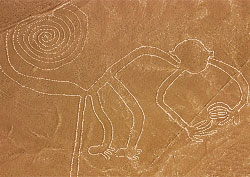Nazca Lines
 Why the
Nazca Lines
are special
Why the
Nazca Lines
are specialThey are a mind boggling set of extremely large scaled drawings etched along an arid coastal plateau. Scholars do not know exactly why and when they were created, and by whom.
Nazca Lines tips and insights
The drawings
The geoglyphs (drawings etched in the earth) include fanciful animal, bird, fish, plant and human figures. Some of them are two football fields wide. The stylized drawings of a monkey (see photo), hummingbird, spider, and a man with an owl shaped head are especially popular with tourists.
The Nazca patterns also consists of numerous geometric patterns. This includes triangles and trapezoids formed by crisscrossing straight lines. Some lines are so long that they stretch beyond the horizon.
The drawings are so expansive that their shapes cannot be recognized from ground level
No one in the last 1000 years knew what they represented until they were seen from the air in the 1920s. Today, there are small local sightseeing planes for tourists.
Theories about the purpose of the Nazca Lines abound
For example, some experts argue that they were used as an astronomical calendar for the benefit of farmers planting and harvesting their crops. Some people speculate that the lines were landing aids for alien spacecrafts. However, the modern day consensus says the Nazca Lines likely had a religious purpose.
Origin
Little is known about the civilization that is now named "Nazca". Many scholars surmise that its geoglyphic constructing period occurred somewhere between 400 BC and 800 AD.
Geoglyphs exist in other parts of the world, but the Nazca Lines are easily the most striking and enigmatic.
Drawing method
Most objects were drawn by digging a narrow, shallow trench. This exposed the light hued subsoil, which markedly contrasts with the plateau's thin reddish-brown surface layer.


